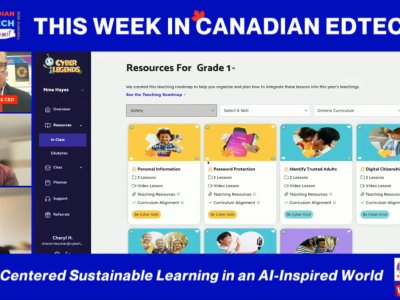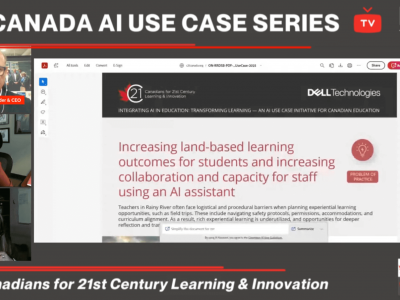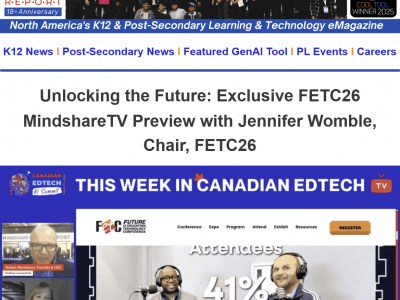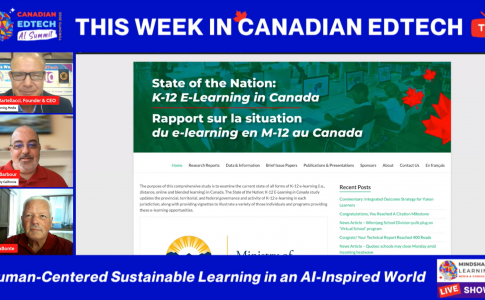Ten years later and we’re still seeing teachers activating student learning through leveraging the use of
technology in the classroom. The MindShare Learning Classroom Video contests over this span of time
have reminded us of the importance of engaging students in learning by providing them with the 'tools
of today' in real-world contexts. We have also noted the importance of embedding deep learning into
our teaching and learning environments. Specifically, we see as pressing the need to support real-world
investigations empowered by teachers committed to igniting learning environments that activate
student voice. But we have noted, in particular, a few overall themes that should not go unnoticed. Let
me briefly outline them below.
Good teachers will always change the learning scape, regardless of the setting. We have seen different
technologies come and go. Some of these technologies have been touted as game changers, however,
none so much so that a good teacher is relegated to the sidelines. We have seen teachers impassioned
by their calling and equipped with growth mindsets making real differences in teaching and learning. We
have watched as teachers have empowered students to own their learning and engage in real-world
problem-solving. And we have observed classrooms exhibit synergies that are dynamic and exciting – a
place where students are equipped to become the leaders of tomorrow. Indeed, technology has played
a role but only as an enhancer of the teaching and learning environments. Good teachers know how to
leverage various technologies to empower pedagogy and engage students in relevant real-world
exercises.
Technology is growing in power and relevance. Ten years ago, we were inundated with interactive
whiteboards and some pretty impressive Web 2.0 tools. Today, we have students as young as five and
six years old coding robots and working with technologies that teach them the basics of STEM. Virtual
and augmented reality is reasonably accessible while learning commons are building makerspaces and
providing opportunities for students that we could only dream of a decade ago. Edtech companies are
becoming more and more aware of the ‘needs’ in education and are beginning to leverage their
expertise to meet these needs. We have applications for electronic portfolios, assessment, math
instruction, and just about any specific curriculum need. And the software is growing more mature.
Students own their learning. We have seen this time and time again showcased in the videos we’ve
watched over the past ten years. In the end, being able to teach yourself is the mark of an educated
person. We have observed more and more how teachers are creating learning environments where
students take charge of their learning and chase after those ideas and projects that interest them and
necessarily develop higher order thinking skills through deep learning contexts. Students come to school
eager to engage in collaborative environments while displaying more mature creative and critical
thinking skills. Students have become the center of learning and teachers are becoming more activators
of this learning while realizing that working collaboratively in teaching teams is most effective.
We have also noticed that classroom environments are evolving into more flexible learning
environments with alternative seating and workspaces that help students to work collaboratively and
comfortably. Learning spaces – the third teacher – give students situations that are more conducive to
learning. Collaborative groups, individual workspaces and technology tools used in every area of the
classroom are more the norm. Teachers are more aware of the need to leverage the workspace so that
students can be more comfortable with the tools that they need to become more successful. We see
that teachers are providing students with the opportunity to dialogue and solve problems together.
We have, of course, noticed the proliferation of Chromebooks and the ever-ubiquitous G Suite for
Education in many schools. The increase of online tools and ‘cloud-based’ learning is growing ever more
mature, and the competition for these spaces has only enhanced what is becoming available to teachers
and students. To say that we can have a paperless school is no longer a dream but a genuine possibility
since WiFi is pretty much standard in most schools across the country. The tools follow the student
rather than the other way around. We have noticed this trend, and we expect that it will only grow and
mature. Wearable technology is just around the corner. Embedded AI and virtual environments will
soon be as standard as the interactive whiteboard was a decade ago.
What can we expect in the next ten years of The Mindshare Learning Video contest? We can expect
more of the same: teachers leveraging digital; students becoming even more empowered by the tools of
tomorrow, and schools and classrooms evolving into ever more robust learning environments. But at the
heart of it, all will be the teacher – teachers who work collaboratively meeting the needs of tomorrow’s
students. Indeed, collective teacher efficacy will become an even more powerful enabler of student
achievement. And with the advent of AI and even more powerful digital tools, we can expect to see even
more innovative teaching and learning in classrooms around the country.
We know that to become a successful teacher in a classroom that embodies all that we know about
good teaching and learning the school environment must be a nurturing teaching and learning
environment. Schools that work together and embrace deep learning provide ‘learningscapes’ that are
idea factories with students fully engaged in learning. Teachers work with teachers to provide schools
that are dynamic, full of positive synergies and life-giving. Next year, MindShare Learning will introduce
a new challenge to support great schools of the future. What does a school of the future embody? Get
your colleagues together and plan now for next year’s contest! We can’t wait to see what you produce!








